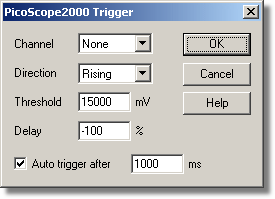|
PicoScope 2000 Trigger |



|
|
Accessed via the Trigger... button in the PicoScope2000 Block-Mode dialog box.
Triggering is used to select the moment at which PicoLog starts collecting data - usually at some fixed time before or after a trigger event. A trigger event occurs when a specified channel crosses a voltage threshold - either rising or falling. PicoLog can start collecting data immediately after the trigger event, or a fixed time interval before or after the trigger event. Channel. This selects which channel is to be used as the trigger input. Select None if a trigger is not required. Note: PicoLog will allow you to trigger on a channel that is not capturing data. However, the channel will need to be activated, and therefore other settings may be affected ... such as the available timebases. If you need to trigger on an inactive channel, we recommend that you use the External Trigger Input. Direction. The trigger direction can be either rising or falling. If rising is selected, the trigger event occurs when the voltage rises across the trigger threshold. Threshold. This shows the voltage (in millivolts) that the trigger channel must cross in order for a trigger event to occur. Delay. This controls the time delay, as a percentage of the sweep time, between the trigger event and the start of collecting data. A negative delay means that the computer will show data that was recorded before the trigger event; for example, -50% places the trigger event in the middle of the collected data and -100% means that all data is collected before the trigger. Note: When a negative delay is selected, the unit will need to buffer enough data before the trigger point. This will stop the unit triggering until it has collected the minimum number of data points. Auto trigger. If you wish PicoLog to trigger after a specified time - even if no trigger event occurs - check the Auto trigger box. Auto trigger after. The time after which PicoLog will trigger automatically, even if no trigger event occurs (only used if the Auto-trigger is enabled). |
